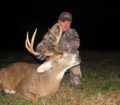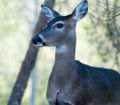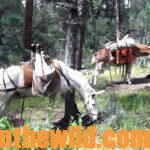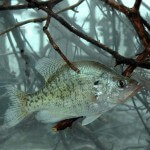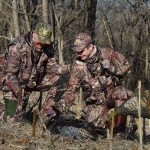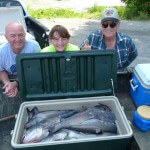John’s Note: Most sportsmen think they must manipulate habitat and provide more food for more deer to manage the wildlife on their lands. But you can have inexpensive deer herd management by applying the tactics of Dr. Grant Woods of Reedsville, Missouri, a well-known wildlife biologist, and other avid outdoorsmen who love developing their lands and deerherds.
“The sustained-yield system of deer management refers to the ability of the land to produce a certain number of animals that can be harvested each season to keep the deer from overbrowsing the land,” Woods says. “To correct this problem in areas where the deer have overbrowsed the land, a hunter must harvest enough does to bring the deer population down to a level where the habitat can produce quality forage and/or improve the habitat with quality plants that hunters can grow in a green field setting. This management method enables you to control the reproductive segment and improve the habitat of the deer herd at the same time. If you rely only on harvesting does to put the herd back in balance with the habitat, you’ll have to bring the deer herd density so low that you’ll have a boring herd to hunt. You won’t see much sign and only a few deer.”
 Woods recommends that along with controlling the deer herd’s growth with your trigger finger that you also increase the amount of available food for the herd by clearing up more land through timber management and using herbicides on weeds to allow more sunlight to reach the forest floor. These techniques, along with planting more green fields, will produce more native plants and make more-nutritious food readily available to the deer herd. Then you can harvest fewer does and see more bucks every time you hunt.
Woods recommends that along with controlling the deer herd’s growth with your trigger finger that you also increase the amount of available food for the herd by clearing up more land through timber management and using herbicides on weeds to allow more sunlight to reach the forest floor. These techniques, along with planting more green fields, will produce more native plants and make more-nutritious food readily available to the deer herd. Then you can harvest fewer does and see more bucks every time you hunt.
What about the Bucks?
“In many parts of the country, hunters have literally raped the male segment of the deer herd because they’ve harvested so many 1-year-old bucks,” Woods emphasizes. “These areas have had a disproportionate number of young bucks harvested, and there’s no longer a natural age structure of both males and females in the deer herd.”
 When you’ve got your finger on your trigger and a young buck in your riflescope, make the decision then as to whether you want to raise the age structure of bucks in your deer herd or keep that age structure at a lower level. If you squeeze the trigger, more than likely your deer herd will continue to only produce younger bucks. If you don’t squeeze the trigger, and the other hunters on the land don’t squeeze their triggers when they have younger bucks in their riflescopes, you’ll all raise the age structure of the bucks in that herd.
When you’ve got your finger on your trigger and a young buck in your riflescope, make the decision then as to whether you want to raise the age structure of bucks in your deer herd or keep that age structure at a lower level. If you squeeze the trigger, more than likely your deer herd will continue to only produce younger bucks. If you don’t squeeze the trigger, and the other hunters on the land don’t squeeze their triggers when they have younger bucks in their riflescopes, you’ll all raise the age structure of the bucks in that herd.
 “I believe that many deer herds across the nation have more adult does and fewer adult bucks than those herds had before Columbus landed in this country,” Woods mentions. “When a deer herd has an out-of-balance sex ratio, you’ll have fawns often born later than they should be. If they’re born after the spring green-up, the native forage isn’t as high in protein as it needs to be for these fawns to meet their physical potential. Too, insect levels are higher, the weather is hotter, and does have to spend more energy to lactate. Also with the fawning season spread out over a longer time, predators can key in to the young fawns as a food source, which makes the fawns’ survival rate even less.”
“I believe that many deer herds across the nation have more adult does and fewer adult bucks than those herds had before Columbus landed in this country,” Woods mentions. “When a deer herd has an out-of-balance sex ratio, you’ll have fawns often born later than they should be. If they’re born after the spring green-up, the native forage isn’t as high in protein as it needs to be for these fawns to meet their physical potential. Too, insect levels are higher, the weather is hotter, and does have to spend more energy to lactate. Also with the fawning season spread out over a longer time, predators can key in to the young fawns as a food source, which makes the fawns’ survival rate even less.”
You’ll learn more deer-hunting information and tips from hunters in John E. Phillips’ Kindle, CreateSpace and Audible books. Go to https://johninthewild.com/books/#deer to purchase and download to your Kindle, and/or download a Kindle app for your iPad, SmartPhone or computer. You also can go to Nook Books at www.barnesandnoble.com to buy.
Also you can download free books by going to https://johninthewild.com/free-books.

